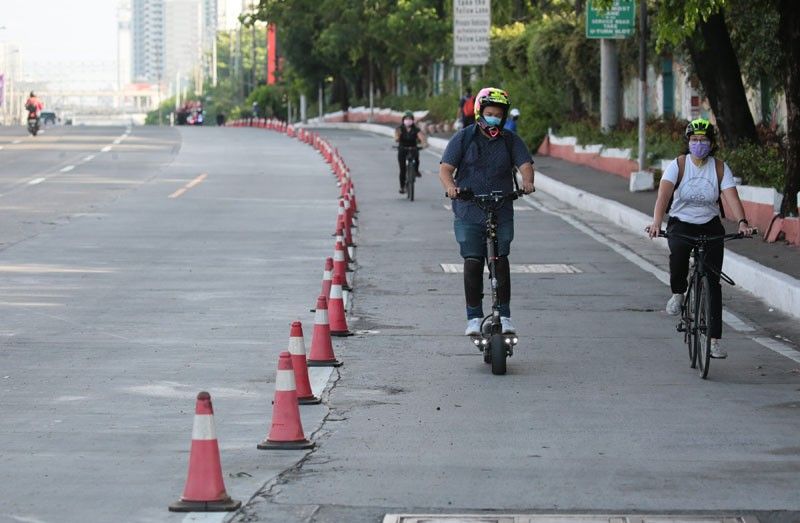The Road Ahead: In Pasig, bike lanes just the start for reimagining road use

This story is part of a series on Metro Manila's cities and how they are promoting cycling and the use of bicycle lanes
MANILA, Philippines — When the coronavirus pandemic shuttered most of public transportation in Metro Manila, thousands looked to cycling to get to work. That was in early 2020.
Against the backdrop of the coronavirus-induced quarantines, the ripple effect in the cycling community has sustained itself to this day. In 2021, the Department of Transportation oversaw the construction of 313.12 kilometers of bike lanes in Metro Manila alone.
As in most of the government’s pandemic response, though, the heavy lifting was given to the local government units. City administrations, in turn, worked in silos and came out with different takes on how to repurpose their roads for the biking public.
Advocates have long called for a reimagination of how we use our roads. But what does this actually mean on the ground, and what kind of insights and best practices can we glean from these different efforts?
Philstar.com spoke to the changemakers themselves, the transportation offices leading the charge in Metro Manila’s local government units, to find out.
Here's what Pasig City had to say about its bike lane network, which was recognized as among the most cyclist-friendly in the country.
Solidarity with barangays, residents helped push bike lanes
In an interview with Philstar.com, Anton Siy, Pasig City's chief transport planner, said that in Pasig, the push for bike lanes was "grown out of the environment department."
"These are all really operational questions...What I'm trying to do now is to be the kind of transport planner that tries to make things better now for walking, cycling and public transport within the limits."
Siy, who earned his master's degree in transport economics from the Institute of Transport Studies in the University of Leeds in the United Kingdom, pointed to the Emerald Avenue open street near the Ortigas Center as one success story for the local government.
On Saturdays, the street is closed off to cars, and families flock there to go cycling, play badminton, or walk their dogs.
"I think that's been really good for us over the years, it's been a great collaboration with the barangay, but also like, it's the product of an alliance we built with some of the building owners in the area," he said.
"It's been a good test case. We're now working with other barangays to get more implementation going with other streets in Pasig. And people love it."
The capacity is there: How much of the heavy lifting in the push for active transportation falls on the local government units compared to the Department of Transportation and the Department of Public Works and Highways?
Siy says even things like managing tricycle traffic and the issuance of building permits are things that "have very significant outcomes not just for cycling and active transport but for the mobility of the city in general."
"There's lots of heavy lifting to be done on both sides. Local governments certainly have a role to play on local streets, like managing the designing and maintenance of roads that are under their jurisdiction," he said.
"If LGUs wanted to build protected bike lanes on every single local road, they have the capacity to, but we really need a strong national push to help us build acceptance. It's a challenge everywhere."
It's not just the bike lanes: While the bike lanes popping up have been the centerpiece of the push for active transportation, Siy also called attention to the infrastructure still needed to serve commuters using those lanes.
For instance, he said, it's not just about bike lanes, but also about bike parking, which he said is equally important yet underdiscussed.
"To really push bike parking, that's something where LGUs can do a lot but certainly the national government could do even more. I think it's a good time to talk about national regulations and standards for bike parking," he said.
"I think they're really easy to implement because no one sees them as much and nobody is annoyed by bike racks. It's all upside and no downside...strong cyclists can cycle without bike lanes, but they won't bike at all if there's nowhere to park."
Siy added that it could be high time for the government to revisit the National Building Code and look into legislating bicycle parking instead of car parking as something that's essential.
Another underreported aspect of the push for active transportation, he said, is e-bikes. According to an article by Bloomberg, rising fuel prices and global coronavirus restrictions have driven e-bike sales exponentially around the United States.
Under the Land Transportation Office's Administrative Order No. 2021-039, though, the operations of electric bicycles and electric kick scooters are limited to barangay roads. They are barred from major urban roads.
"I think this is really important. I'm a big believer in e-bikes, and I think they're one of the key solutions to getting people out of cars and making more houses car-free going forward."
What about the bike-share system proposed by the national government? Siy expressed support for the idea but said that on a local level, they could be "quite a complicated operation."
"You have to consider so much more than putting the racks on the ground...can you create the kind of land-use rights that allow you to reach that density?"
He also shared the challenge of meeting the needs of a bike-share service's target market.
"You're talking about people who are willing to bike but are not invested enough in cycling to own their own bike yet. So by definition, you're talking about newbie cyclists. If these are your customers [...] is the rest of your transportation ready to support the system?"
READ: Commuters might soon see gov't bike share system, end-of-trip bike facilities
The Kapitolyo intersection will open permanently starting today, 15 SEP 2021. Additional painting and installation of bike lane bollards in the coming days.
— PasigTransport (@PasigTransport) September 15, 2021
Do you want to see more human-centered infra in the city? Tell us where you’d like to see improvements in the city! pic.twitter.com/CS82zxpib6
Enforcement-centric culture, attitudes: Siy said that some traffic enforcers and city engineers across Metro Manila "aren't in the right mindset" for proactive and sustainable transport.
"Oftentimes, the success indicator is vehicle speed, when it's uncongested," he said, adding that many still "don't yet accept that you could actually have better outcomes on a road by narrowing the vehicle lanes and widening the sidewalk."
Promoting a better culture surrounding active transportation, Siy says, is a political problem faced by many cities around the world.
"It's always the same thing. There will always be somebody who hates the transformation of streets towards active transportation," he said.
"I think at first, before you do it, everyone hates the idea...but surprisingly, some (barangay) captains said they made it safer for them to go on morning walks."
Organizing efforts to push for active transport: How do we push back against that culture?
Siy said that most bike lanes we see today are the result of "years of civil society organizing towards cementing that as an apolitical and cultural norm."
"I think the one thing that also unites all of our offices is that we're the bike offices that are led by people who actually bike so they bike, like, every day and not just on the weekend," he said, adding that opposition to active transportation is more often than not a "small but really loud minority."
"Being able to smartly build alliances that can counteract that, I think that's where a lot of the real work in this field is."
- Latest
- Trending






























